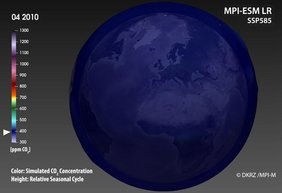Knowing the pathways of anthropogenic CO2 in the climate system is crucial to verify the effectiveness of fossil fuel emissions reduction measures. Predictions of the near‐term evolution would assist policy‐relevant analysis and carbon management activities. Lead author Dr. Tatiana Ilyina: “The question was: Can we predict if atmospheric CO2 changes slower or faster than expected from changes in emissions?”
The answer to this question is not straightforward because variations of the natural land and ocean carbon sinks in response to climate variability strongly regulate year‐to‐year variations in the growth rate of atmospheric CO2.
To address the problem, the authors used different prediction systems that are based on Earth-system models and initialized by the observed state of the physical climate to assess how well these capture variations of the global land and ocean carbon sinks and their predictability. For the first time they examined the resulting predictability of variations in the growth rate of atmospheric CO2 that is driven by the response of carbon sinks to climate variability.
For the globally integrated ocean carbon sink, they showed predictability horizons of up to six years for some models, with even higher regional predictive skill in the Southern Ocean, North Atlantic, and North Pacific. For the land carbon sink, the scientists found that variations are predictable up to two years and thus limit predictability of changes in atmospheric CO2 growth rate to two years.
The improved predictive skills offer a powerful tool in support of decisions related to carbon management. They will help to verify near-term carbon emission reduction pathways and assess their efficiency.
Original publication
Ilyina, T., Li, H., Spring, A., Müller, W. A., Bopp, L., Chikamoto, M. O., et al. (2020). Predictable variations in the carbon sinks and atmospheric CO2 growth in a multi-model framework. Geophysical Research Letters, 47. doi: 10.1029/2020GL090695
Contact
Dr. Tatiana Ilyina
Max Planck Institute for Meteorology
Email: tatiana.ilyina@mpimet.mpg.de
Dr. Hongmei Li
Max-Planck-Institut für Meteorologie
E-Mail: hongmei.li@mpimet.mpg.de
Aaron Spring
Max-Planck-Institut für Meteorologie
E-Mail: aaron.spring@mpimet.mpg.de
Dr. Wolfgang Müller
Max-Planck-Institut für Meteorologie
E-Mail: wolfgang.mueller@mpimet.mpg.de

